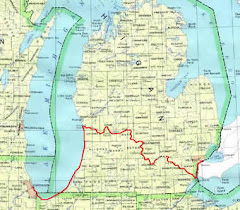
Continuing from my article in "Wooden Canoe".
The Bark Canoes and Skin Boats of North America by Edwin Tappen Adney and Howard I. Chappelle devotes an entire chapter to 'Temporary Craft'. The authors state, " The details of the construction of elm canoes (and of bark other than birch) by the Iroquois are speculative since no bark canoe of their construction has been preserved."
They also state that " war parties and hunters often found it necessary to build a temporary canoe, one that could be utilized for a limited water passage and then abandoned."
Adney and Chappelle draw from the writings of another 17th Century Frenchman, Joseph Francois Fitau, a description of the Iroquois elm-bark canoe as very coarsely built of a single large sheet of bark, crimped along the gunwale, with ends secured between battens of split saplings. The gunwales, ribs and thwarts were described as " tree branches" implying that the outer bark had not been removed.
La Fitau's description is quite similar to LaSalle's, but LaSalle does not mention the crimps. This omission could mean LaSalle did not crimp his elm bark but merely fastened the ends together thus making a canoe with no rocker.
The detailed procedures for building an Iroquois elm-bark canoe contained in The Bark Canoes and Skin Boats of North America are primarily based on a 1749 account by a Swedish traveler to North America, Professor Pher Kalm.
Among the pertinent details are: 1) In warm weather the bark could be removed without much difficulty, but in the spring or fall it might be necessary to apply heat. 2) If possible the bark was stripped from the standing tree...felling was avoided for fear of harming the bark. 3)The rough outer bark was scraped away; if the builder was hurried, the scraping was confined to the areas being sewn or folded. The bark was then laid on a cleared piece of ground...with the outside of the bark up, so it would be inside the finished boat. 4) One requirement in building these canoes was to crimp the edges of the bark at the gunwales in such a manner that the bottom of the canoe would be rockered and at the same time molded athwartships. 5) Water tightness was insured by merely forcing clay into the stems from the inside, or by forcing in a wad of the pounded bark of a dead red (slippery) elm which would swell when damp.
LaSalle's men built the canoe in cold, early April weather. His account says they had to use boiling water to loosen the bark.
LaSalle says he had the tree cut down. This was probably necessary to apply the boiling water. Imagine chopping down an elm tree---with only the hatchets they carried---large enough to obtain a single canoe-size piece of bark.
It must have been a large canoe. It had to accommodate six men, together with what LaSalle listed as their gear: blankets, clothing, kettles, hatchets, guns, powder, lead, skins to make moccasins ( they were constantly wearing out), snow shoes (which they probably discarded early on), knives and hatchets for trade goods, and of course, food.
(My article goes on for several more fairly technical paragraphs which I will be glad to share with anyone who is interested.).
Now back to LaSalle and the fate of his men and their canoe. Ironically, their elm-bark canoe did not serve its intended purpose. As LaSalle said about their journey on the Huron:
"...as the river was almost everywhere encumbered by heaps of wood which the swollen waters carried down or cast into its bed, we got weary of carrying our baggage every moment when the masses of wood prevented the canoe from passing, moreover the river made enormous bends..."
They finally figured out that in five days of struggling with their canoe on the choked-up river they had made no more progress than one day's march on land. Therefore they abandoned the canoe and walked the rest of the way to the Detroit River.
I have self-published a comprehensive, illustrated study of elm bark canoes under the same title as this article. Take a look at it when you visit my display at the Quiet Water Symposium at MSU on Saturday March 7.
Erik Vosteen and Kevin Finney, a pair of midwestern primitive technologists, have constructed an elm-bark canoe. The photo above is from their web page. See the whole process at their website: <http://www.burntmud.com/canoe.htm >


1 comment:
Hello Thank you for such a informative blog post. You mentioned you have self published a comprehensive study on elm bark canoes. Is there a way I can get in touch or order this or read this information? once again thank you.
My Best,
James
Post a Comment